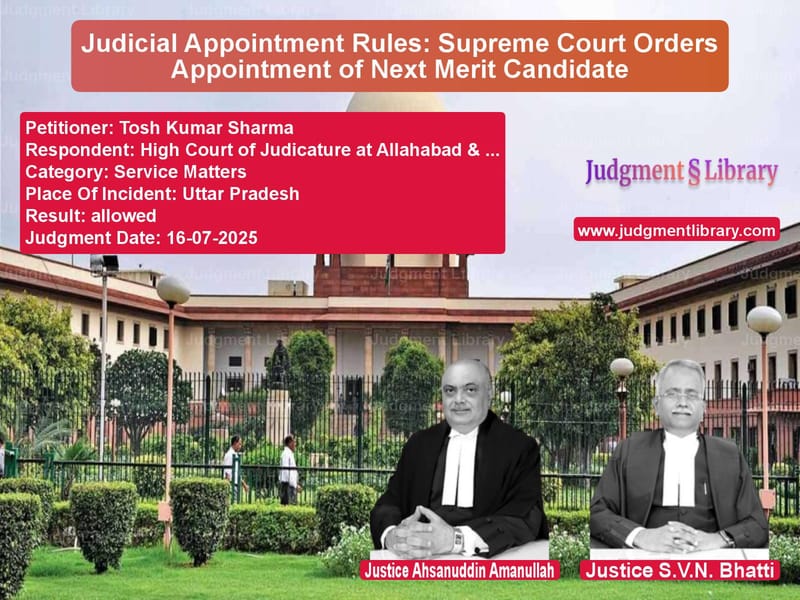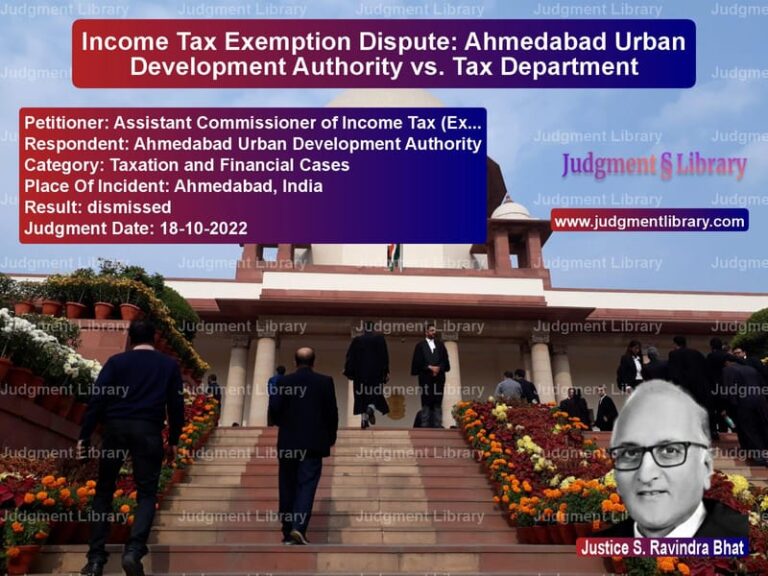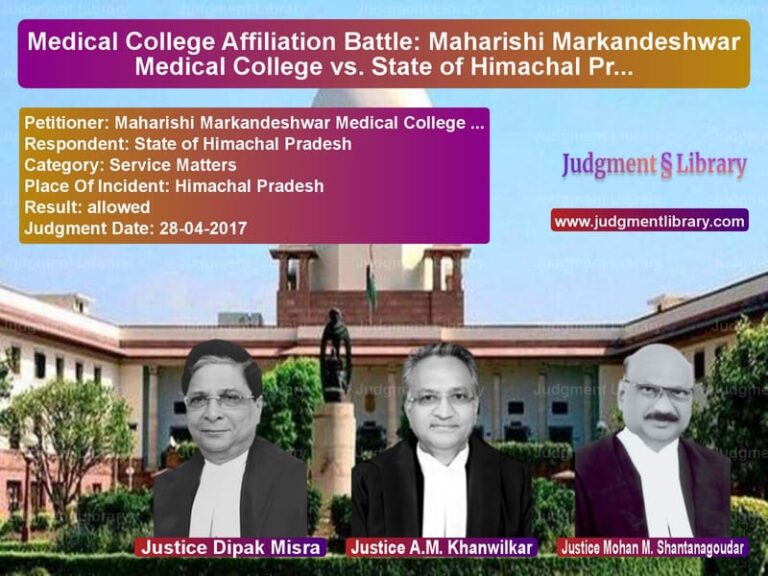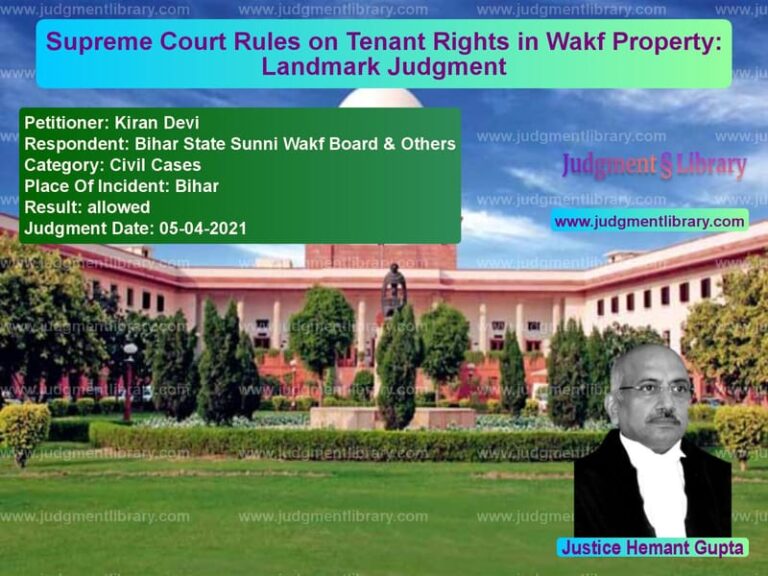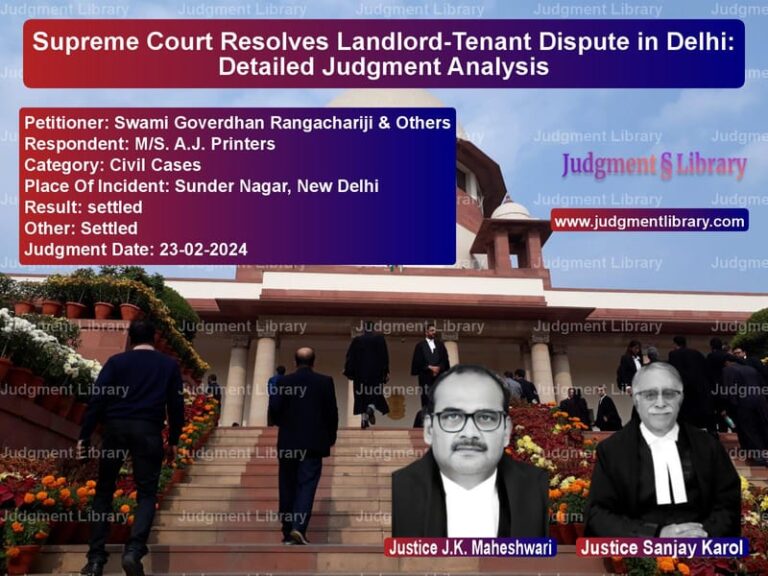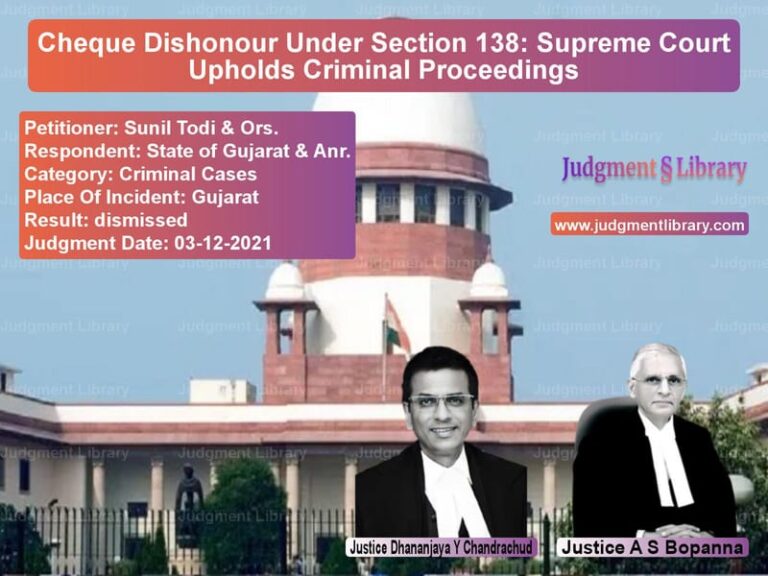Judicial Appointment Rules: Supreme Court Orders Appointment of Next Merit Candidate
In a significant ruling that clarifies the legal position on filling judicial vacancies, the Supreme Court has directed the appointment of Tosh Kumar Sharma as Additional District and Sessions Judge, setting aside the Allahabad High Court’s decision to carry forward a vacancy instead of appointing the next candidate in the merit list. The judgment provides important insights into the interpretation of recruitment rules and the proper procedure for filling vacancies that arise during the selection process.
The case originated from the 2016 recruitment process for the Uttar Pradesh Higher Judicial Service, where thirty-seven vacancies were advertised in the General Category. Tosh Kumar Sharma had secured the 38th position in the merit list, just below the last candidate who was recommended for appointment. However, when one of the thirty-seven recommended candidates was not approved by the Governor, instead of appointing Sharma as the next candidate in line, the High Court decided to carry forward the vacancy to the next recruitment cycle, leading to the legal dispute.
Appellant’s Arguments
Mr. Sinha, learned senior counsel for the appellant, contended that once the vacancies as per the 2016 Advertisement were for thirty-seven persons in the General Category, the entirety of the said thirty-seven vacancies had to be filled up from the same selection process. It was urged that there cannot be any question of carry-forward of any vacancy in the facts of the present lis, for the reason that it was not the case of a casual vacancy having arisen after the candidates concerned had joined their posts. Rather, it was a case where one recommended candidate was not finally approved by the Hon’ble Governor/State Government, which made the thirty seventh post available and vacant for recruitment. In such a scenario, as canvassed by Mr. Sinha, it was incumbent upon the High Court to recommend/forward the name of the next eligible candidate, which, as per the Merit List, was the present appellant.
It was further argued that Rule 8(2) of the Uttar Pradesh Higher Judicial Service Rules, 1975 (hereinafter referred to as the ‘Rules’), being relied upon by the High Court, is not attracted in the facts at hand as the same is applicable only when the persons finally found eligible for being recommended for appointment is less than the total posts available, which is not the situation herein as there were more than thirty-seven persons available and eligible. Due to the restriction of thirty-seven posts, as pointed out above, only thirty-seven names were finally recommended to the Hon’ble Governor/State Government, out of which only 36 candidates found favour.
Respondent’s Submissions
Per contra, Ms. Dwivedi, learned counsel for the High Court, in support of the Impugned Judgment, submitted that the appellant may not be eligible for the reason that there was one candidate (Mr. Shakir Hasan) belonging to the Other Backward Classes Category (hereinafter referred to as the ‘OBC Category’), who had fared better than the appellant in the Merit List, and if somebody was to be appointed for the said thirty seventh post, it would be Mr. Shakir Hasan. On the direct query as to whether the appointment of Mr. Shakir Hasan had materialised, learned counsel informed us that he had been appointed, treating him as falling in the OBC Category.
Learned counsel referred to the Counter-Affidavit to submit that in accordance with Rule 8(2) of the Rules, after the candidature of one recommended person was not approved by the Hon’ble Governor/State Government, the Selection and Appointment Committee vide Minutes dated 19.06.2020 had resolved, inter alia, as under: ‘…The post now vacated after the cancellation of his candidature will be accounted for in the next recruitment process as an unforeseen vacancy. It is also resolved that promotion under Rule 8(2) of Rules, 1975 against one post be made so that necessary compliance of the order of Apex Court in Malik Mazhar Sultan’s case may be ensured.’
Court’s Analysis and Important Arguments
The Supreme Court began by acknowledging the special position of High Courts in matters relating to judicial services, noting that Article 235 of the Constitution bestows complete, exclusive and effective control over Judicial Officers, encompassing appointment, removal, reduction of rank, dismissal, transfer, promotion etc. on the concerned High Court. However, the Court emphasized that even this extensive authority must be exercised in accordance with established rules and principles.
The Court meticulously analyzed Rule 8(2) of the Uttar Pradesh Higher Judicial Service Rules, which states: ‘If at any selection the number of selected direct recruits available for appointment is less than the number of recruits decided by the Court to be taken from that source, the Court may increase correspondingly the number of recruits to be taken by promotion from the Nyayik Sewa.’
The Court made a crucial distinction in interpreting this rule: Rule 8(2) is not mired in complexity. As per the contention of the High Court, the thirty seventh post was a vacancy which had to be carried forward, and was done so by the Selection and Appointment Committee, which also resolved to make a promotion against one post as per the orders passed at different points in time in Malik Mazhar Sultan and Anr. v Uttar Pradesh Public Service Commission and Ors., Civil Appeal No.1867/2006. On deeper scrutiny, our finding is that Rule 8(2) of the Rules does not apply to the situation confronting the High Court upon the rejection of one candidature by the Hon’ble Governor/State Government from out of the communicated list. The first portion of Rule 8(2) of the Rules itself contemplates that the said Rule is attracted only when the number of ‘selected direct recruits available for appointment’ is less than the number of direct recruit vacancies, i.e., vacant posts available/advertised. In the absence of this condition being satisfied, the High Court is not under obligation to act in terms of Rule 8(2) of the Rules.
The Court provided a detailed interpretation of the key phrase ‘selected direct recruits available for appointment’: The terminology employed in Rule 8(2) is ‘selected direct recruits available for appointment’. Had the term only been ‘selected direct recruits’, we could have upheld the contentions of Ms. Dwivedi. However, this is immediately followed by ‘available for appointment’. The provision fundamentally negates any option of approving the High Court’s invocation of Rule 8(2) of the Rules, as the said Rule itself is cognizant of availability for appointment. This implies that it accounts for a situation wherein, for instance, a Merit List contains eleven candidates, but the recruitment process culminates in recommending ten candidates for notification. If the top ten candidates are approved by the Hon’ble Governor/State Government, the person placed at the eleventh position is out of the game. However, if, for any reason, one or more of the top ten candidates do not get approved for appointment, the eleventh-ranked candidate from the same selection process is entitled to be offered an appointment. This logically flows from reading and construing ‘selected direct recruits available for appointment’ as a whole.
The Court further clarified: Rule 8(2) could have been pressed into service when, exempli gratia, vacancies advertised were ten, but only nine candidates figured in the Merit List, leaving one clear vacancy, which would be filled-up from the Nyayik Sewa by way of promotion, and also adjusted in the next recruitment cycle for direct recruits correspondingly, as per the proviso to Rule 8(2), such that the direct recruits do not ever exceed 25% strength of the service.
The appellant was placed at the thirty eighth position in merit, alongside others ranking below him, who were all eligible for appointment, i.e., ‘available for appointment’. However, due to the limited number of posts, i.e., thirty-seven in the General Category, the top thirty-seven from the Merit List were recommended for final appointment. As fate would have it, the candidature of one originally recommended person did not materialise into an appointment, and the said person accepted the position.
Court’s Final Ruling
In light of the above, we are unable to justify the denial of recommendation and consequential appointment of the appellant. For the sake of clarity, this is not a case where the appellant is ineligible or otherwise disqualified for appointment. This is also not a case where a ‘continuing wait list’ is being created. For the reasons stated above, this appeal is allowed. The Impugned Judgment is set aside.
The Supreme Court directed: The High Court and the State Government are directed to process and issue Appointment Letter to the appellant. His seniority would be reckoned notionally as part of the 2016 Advertisement’s selection process. Needless to state, no back-wages or any other emoluments preceding the date of actual joining in service shall be due and/or payable to the appellant. The entire exercise, including necessary formalities, shall be completed within two months from the date. The appellant shall be assigned a posting, and shall complete the prescribed training.
In a significant concession to ensure finality, the Court also ordered: Learned counsel for the High Court, at this juncture, prayed that to put an authoritative quietus to the issue(s) and prevent further litigation concerning inter-se seniority, this Court may direct that the appellant be placed below the last-appointed candidate in the same selection process. Finding merit in the request made, the same was put to the learned senior counsel for the appellant. On instructions, learned senior counsel does not oppose such a proposal. Ordered accordingly – the appellant shall be placed immediately below all persons appointed pursuant to the 2016 Advertisement, including Mr. Shakir Hasan, to reckon his seniority and entry into service without financial commitments to the State Government.
This judgment establishes an important precedent for judicial appointments across the country, emphasizing that when vacancies arise during the selection process due to non-approval of recommended candidates, the next eligible candidate in the merit list should be appointed rather than carrying forward the vacancy to future recruitment cycles. The ruling balances the High Court’s administrative autonomy with the principles of fairness and rule-based recruitment processes.
Petitioner Name: Tosh Kumar Sharma.Respondent Name: High Court of Judicature at Allahabad & Ors..Judgment By: Justice Ahsanuddin Amanullah, Justice S.V.N. Bhatti.Place Of Incident: Uttar Pradesh.Judgment Date: 16-07-2025.Result: allowed.
Don’t miss out on the full details! Download the complete judgment in PDF format below and gain valuable insights instantly!
Download Judgment: tosh-kumar-sharma-vs-high-court-of-judica-supreme-court-of-india-judgment-dated-16-07-2025.pdf
Directly Download Judgment: Directly download this Judgment
See all petitions in Employment Disputes
See all petitions in Recruitment Policies
See all petitions in Public Sector Employees
See all petitions in Judgment by Ahsanuddin Amanullah
See all petitions in Judgment by S.V.N. Bhatti
See all petitions in allowed
See all petitions in supreme court of India judgments July 2025
See all petitions in 2025 judgments
See all posts in Service Matters Category
See all allowed petitions in Service Matters Category
See all Dismissed petitions in Service Matters Category
See all partially allowed petitions in Service Matters Category

